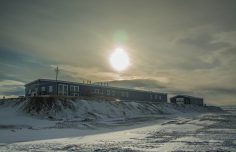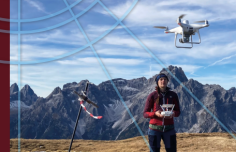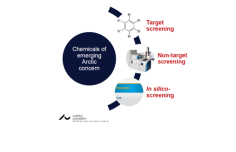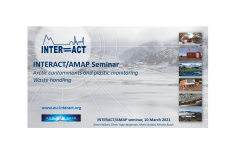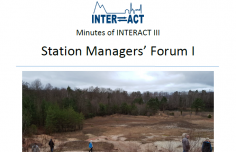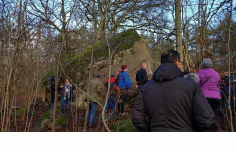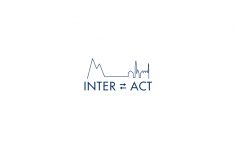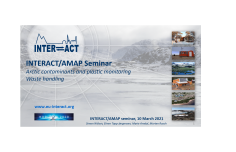ArcticDefinitions of the Arctic vary according to environmental, geographical, political, cultural and scientific perspectives. Some scientists define the Arctic as areas having a high latitude, long winters, short, cool summers,... More Monitoring and Assessment Programme. One of the working groups of the ArcticDefinitions of the Arctic vary according to environmental, geographical, political, cultural and scientific perspectives. Some scientists define the Arctic as areas having a high latitude, long winters, short, cool summers,... More Council. Established in 1991. AMAPArctic Monitoring and Assessment Programme. One of the working groups of the Arctic Council. Established in 1991. AMAP is responsible for measuring the levels of pollutants in the Arctic, and... More is responsible for measuring the levels of pollutants in the ArcticDefinitions of the Arctic vary according to environmental, geographical, political, cultural and scientific perspectives. Some scientists define the Arctic as areas having a high latitude, long winters, short, cool summers,... More, and assessing their effects on the environment and people. AMAPArctic Monitoring and Assessment Programme. One of the working groups of the Arctic Council. Established in 1991. AMAP is responsible for measuring the levels of pollutants in the Arctic, and... More also documents trends of pollution and the sources and pathways of pollutants. It examines the impact of pollution on ArcticDefinitions of the Arctic vary according to environmental, geographical, political, cultural and scientific perspectives. Some scientists define the Arctic as areas having a high latitude, long winters, short, cool summers,... More floraThe plants that live in a particular region, habitat or time (such as geological period like the jurassic). For animals, we use the term fauna, and to collectively refer to all... More and faunaThe animals that live in a particular region, habitat or time (such as geological period like the jurassic). For plants, we use the term flora, and to collectively refer to all... More, especially those used by indigenousBelonging to a certain place. Indigenous people are distinct ethnic groups that have historic connections to people who lived in a territory prior to the area being colonized or coming... More people. It reports on the state of the ArcticDefinitions of the Arctic vary according to environmental, geographical, political, cultural and scientific perspectives. Some scientists define the Arctic as areas having a high latitude, long winters, short, cool summers,... More environment and gives advice to governments on priority actions needed to improve the ArcticDefinitions of the Arctic vary according to environmental, geographical, political, cultural and scientific perspectives. Some scientists define the Arctic as areas having a high latitude, long winters, short, cool summers,... More condition. Early reports from AMAPArctic Monitoring and Assessment Programme. One of the working groups of the Arctic Council. Established in 1991. AMAP is responsible for measuring the levels of pollutants in the Arctic, and... More led to the establishment of the ArcticDefinitions of the Arctic vary according to environmental, geographical, political, cultural and scientific perspectives. Some scientists define the Arctic as areas having a high latitude, long winters, short, cool summers,... More Council Action Plan to Eliminate Pollution of the ArcticDefinitions of the Arctic vary according to environmental, geographical, political, cultural and scientific perspectives. Some scientists define the Arctic as areas having a high latitude, long winters, short, cool summers,... More (ACAPArctic Contaminants Action Program. One of the working groups of the Arctic Council, formally established in 2006. The goal of ACAP is to reduce emissions of pollutants into the environment... More). A further follow-up to AMAPArctic Monitoring and Assessment Programme. One of the working groups of the Arctic Council. Established in 1991. AMAP is responsible for measuring the levels of pollutants in the Arctic, and... More was the ArcticDefinitions of the Arctic vary according to environmental, geographical, political, cultural and scientific perspectives. Some scientists define the Arctic as areas having a high latitude, long winters, short, cool summers,... More ClimateThe average weather we would expect over a long period of time (seasons, years, decades). Climate varies from place-to-place across the Earth. Climate is determined by long-term (over at least... More Impacts Assessment (ACIAArctic Climate Impact Assessment. A collaborative project of the Arctic Council and IASC. Started in 2000, the aim is to gather and assess knowledge about climate variability, climate change and increased ultraviolet radiation in the Arctic.... More).
Related contents
-
> Villum Research Station
Field SitesNAME AND OWNER Villum Research Station, Station Nord (Villum) consist of a garage for storage of vehicles and a tents, generators etc. for a mobile …
> Read more -
> INTERACT reducing CO2 emissions in Arctic Science
PublicationsThe polar scientific community is engaged in various types of fieldwork, conferences, education, training and collaboration, which all come with a significant carbon footprint. Many …
> Read more -
> Rising Chemical Contaminants in the Arctic: New deliverable report from WP8
NewsINTERACT WP 8, Cleaner ArcticDefinitions of the ArcticDefinitions of the Arctic vary according to environmental, geographical, political, cultural and scientific perspectives. Some scientists define the Arctic as areas having a high latitude, long winters, short, cool summers,... More vary according to environmental, geographical, political, cultural and scientific perspectives. Some scientists define the ArcticDefinitions of the Arctic vary according to environmental, geographical, political, cultural and scientific perspectives. Some scientists define the Arctic as areas having a high latitude, long winters, short, cool summers,... More as areas …
> Read more -
> Save the date! Hybrid workshop on deploying passive samplers at ArcticNet 7 December
NewsWelcome to a workshop between INTERACT partners and other network representatives regarding the deployment of passive samplers which will be held on Wednesday 7 December …
> Read more -
> New catalogue listing local and transboundary emerging pollutants
NewsA new deliverable report D8.1 “Catalogue listing local and transboundary emerging pollutants” is now available. Based on AMAPArctic Monitoring and Assessment Programme. One of the …
> Read more -
> Joint INTERACT AMAP workshop on contaminant monitoring and waste handling at INTERACT Stations
Meetings INTERACT IIIBelow you can download the presentations from the seminar. The seminar had two separate sessions: 1) AMAPArctic Monitoring and Assessment Programme. One of the working …
> Read more -
> Station Manager’s Forum Seminar today
NewsToday, at 17.00-19.00 CET, an INTERACT Station Managers’ Forum Seminar will be held focusing on AMAPArctic Monitoring and Assessment Programme. One of the working groups …
> Read more -
> Station Managers’ Forum I
Meetings INTERACT IIIThe first Station Managers’ Forum in INTERACT III, was held at Bäckaskog Castle in southern Sweden. 42 INTERACT stations were represented at the meeting along …
> Read more -
> Station Managers’ Forum VI
Meetings42 INTERACT stations were represented at the meeting along with representatives from a number of external partners and collaborators, e.g. AMAPArctic Monitoring and Assessment Programme. …
> Read more -
> Release of 5 AMAP Assessments
NewsOn the 25th of April 5 new AMAPArctic Monitoring and Assessment Programme. One of the working groups of the ArcticDefinitions of the Arctic vary according to environmental, geographical, political, cultural and scientific perspectives. Some scientists define the Arctic as areas having a high latitude, long winters, short, cool summers,... More Council. Established in 1991. AMAPArctic Monitoring and Assessment Programme. One of the working groups of the Arctic Council. Established in 1991. AMAP is responsible for measuring the levels of pollutants in the Arctic, and... More …
> Read more -
> Pollution
Cleaner ArcticDefinitions of the Arctic vary according to environmental, geographical, political, cultural and scientific perspectives. Some scientists define the Arctic as areas having a high latitude, long winters, short, cool summers,... More, cleaner world: documenting and reducing pollution WP8 is designed to focus on emerging contaminants of concern from local sources of pollution and also …
> Read more -
> SWIPA
Glossary“Snow, Water, Ice, PermafrostPermafrost is frozen ground that remains at or below zero degrees Celsius (32 degrees Fahrenheit) for two or more years. It forms …
> Read more -
